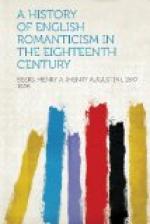MacPherson translated—or composed—his “Ossian” in an exclamatory, abrupt, rhapsodical prose, resembling somewhat the English of Isaiah and others of the books of the prophets. The manners described were heroic, the state of society primitive. The properties were few and simple; the cars of the heroes, their spears, helmets, and blue shields; the harp, the shells from which they drank in the hall, etc. Conventional compound epithets abound, as in Homer: the “dark-bosomed” ships, the “car-borne” heroes, the “white-armed” maids, the “long-bounding” dogs of the chase. The scenery is that of the western Highlands; and the solemn monotonous rhythm of MacPherson’s style accorded well with the tone of his descriptions, filling the mind with images of vague sublimity and desolation: the mountain torrent, the dark rock in the ocean, the mist on the hills, the ghosts of heroes half seen by the setting moon, the thistle in the ruined courts of chieftains, the grass whistling on the windy heath, the blue stream of Lutha, and the cliffs of sea-surrounded Gormal. It was noticed that there was no mention of the wolf, common in ancient Caledonia; nor of the thrush or lark or any singing bird; nor of the salmon of the sealochs, so often referred to in modern Gaelic poetry. But the deer, the swan, the boar, eagle, and raven occur repeatedly.
But a passage or two will exhibit the language and imagery of the whole better than pages of description. “I have seen the walls of Balclutha, but they were desolate. The fire had resounded in the halls, and the voice of the people is heard no more. The stream of Clutha was removed from its place by the fall of the walls. The thistle shook there its lonely head; the moss whistled to the wind. The fox looked out from the windows, the rank grass of the wall waved round its head. Desolate is the dwelling of Moina, silence is in the house of her fathers. Raise the song of mourning, O bards, over the land of strangers. They have but fallen before us; for, one day, we must fall. Why dost thou build the hall, son of the winged days? Thou lookest from thy towers to-day; yet a few years, and the blast of the desert comes; it howls in thy empty court, and whistles round thy half-worn shield."[3] “They rose rustling like a flock of sea-fowl when the waves expel them from the shore. Their




